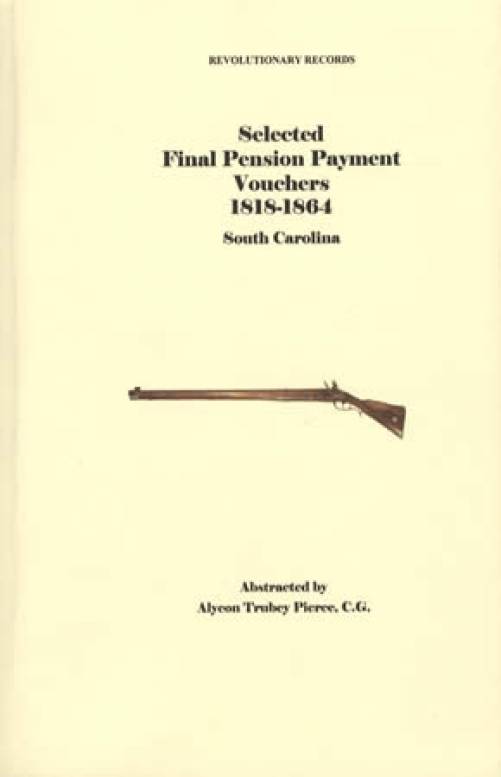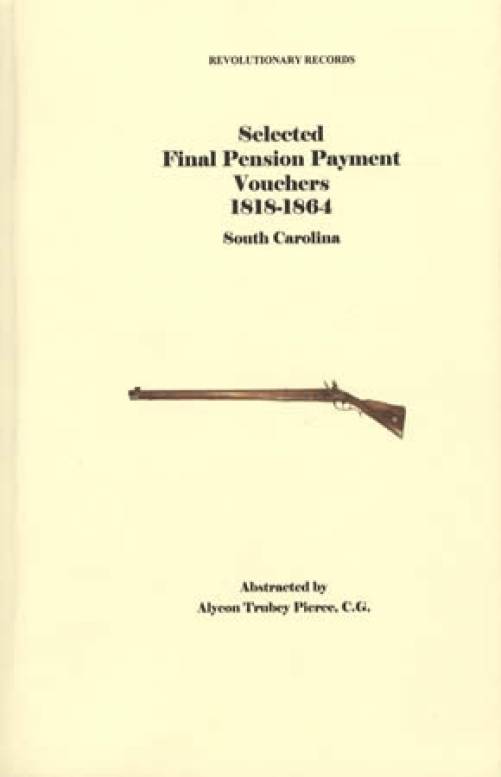New Papyrus Publishing
Selected Final Pension Payment Vouchers 1818-1864 South Carolina by Alycon Trubey Pierce
Selected Final Pension Payment Vouchers 1818-1864 South Carolina by Alycon Trubey Pierce
Couldn't load pickup availability
The original records abstracted for these publications below belong to the Records of the Accounting Officers of the Department of the Treasury (Record Group 217). The National Archives description for this specific collection of Third Auditor records is "Entry 722: Selected Final Payment Vouchers, 1818-1864." The National Archives staff formed this collection by culling only the "settled accounts" or very last payments made by each pension office to each pensioner. The National Archives and Records Administration (NARA) describes this collection as follows, from a current hand-out given to researchers:
"Final Pension Vouchers Revolutionary War"
Recognizing the great genealogical value of the final pension vouchers and the difficulty in locating them among the pension agents' accounts, the National Archives located and removed these vouchers from the voluminous accounts of the pension agents, thus rendering them more accessible to researchers and the staff of the National Archives. This project, which took about five years to complete, resulted in the segregation of about 55,000 final or last payment vouchers and the creation of an index to these vouchers. The segregated vouchers are arranged by State and then alphabetically by name of pensioner; the index is alphabetical. The final payment is the record of the "final" payment paid to the heirs of a pensioner after his death. If the heirs did not file for the money that was due the pensioner from the time of the receipt of his last pension payment until the time of his death[,] there is no final payment, only a "last" payment. The removal of the final or last payment vouchers was a time-consuming and involved project, requiring thousands of staff-hours of work. From the registers of payments to United States pensioners (available on microfilm as T718), the name of every Revolutionary War veteran paid under the acts of 1818, 1828, and 1832 was placed on a 3 x 5 index card. The following information obtained from the registers was also included on the card: place where the pension agent was located, the act under which payment was made, date of death, and date either of the final or of the last payment. The date of the last payment to the pensioner was recorded only if there was no indication in the register that a final payment had been made to his heirs. The accounts of the appropriate pension agent were then searched. If the voucher was located, it was removed and placed in an acid-free envelope, the proper index card was then annotated with the asterisk (*) to indicate that the voucher had been located and withdrawn. The same procedures were followed for widows and invalid pensioners; only if the ledgers indicated that a final payment had been made after their death. No search was conducted for the last payment vouchers for these individuals. The Central Reference Staff of the National Archives will search the index cards and the segregated vouchers. If the requested voucher is not among these files, no further searching will be made except in the cases where the researcher has determined from the registers of payments (microfilm T718) that final payment was made. The researcher must provide the staff with the name of the pensioner, the location of the pension agency, the act under which he was paid, the date of death, and the date of the final payment. This information is available from the pension application files and the registers of payments. The Central Reference Staff will not search for last payment vouchers. Despite the title of this NARA hand-out, not all vouchers pertain to Revolutionary War pensioners. Others claim service in the War of 1812, Florida War, and Seminole War, or regular army service. Neither do these vouchers represent every pensioner paid by any given pension office. Further, the pension act of 6 April 1838 resulted in a collection of pension payment vouchers which were not handled by the various pension agencies but by the Treasury Department itself (RG 217, Entry 724). Those vouchers contain the very same types of information, but were neither culled nor indexed by the NARA staff in their above-described project. Last and final pension payment vouchers contain a variety of "extra" data, such as the maiden names of widows, and their full dates and places of marriage (sometimes supplied by attendees or the celebrant). One such marriage record in Louisiana among these vouchers was transcribed by the priest at St. Louis Cathedral, and gives the parentage of both bride and groom as well as the groom's birthplace. In another instance, a coroner's report confirms that a veteran drowned in Lake Pontchartrain when the steamboat he was riding burned to the water's edge. And, in a final example, a 32-year-old veteran's death was reported by his brother-in-law, who identified not only the exact time of death, but the place as well, right down to the French Quarter street location and the proprietor's name of the coffee house (suggesting that perhaps one can have one too many beignets).
Last Payments
Last pension payment records adhered to certain prescribed guidelines, containing certain elements fairly consistent among all such records. The prescribed formats to be used appear in the Appendix. First, the pensioner was required to furnish evidence of his or her pension; this typically resulted in a recitation of the veteran's rank, the date of the pension act under which he or she drew a pension, and usually a statement as to his or her present and former residences. Earlier final payment records often give much more specificity as to the pensioner's service, giving superior officers' names as well as the regiment in which he served, but less information as to former residences. From this section, the pensioner's rank and residence information, and his ability to sign his name were abstracted. Next, the pensioner gave power of attorney to someone to go to the pertinent pension office and collect his payment, specifying the beginning and ending dates of the payment period. Most of the persons so appointed resided in the pension office city, although less often a neighbor or kinsman was given power of attorney. The names of all persons given powers of attorney were abstracted, since these could be kinsmen or neighbors. Wherever a relationship between the pensioner and his attorney was stated, or the attorney's residence other than the pension office city was stated, these data were also abstracted. It should be assumed that all attorneys could sign their names unless their mark is noted. Such powers of attorney needed to be acknowledged before a local magistrate or witnessed by two witnesses. Witness or magistrate names were extracted. Local authorities then attested to the validity or terms of office for justices of the peace or magistrates who signed the pensioners' powers of attorney; none of this information is abstracted. Acting attorneys presented themselves before authorities local to them to sign a standard statement indicating that they understood they were to collect and return all monies collected to the pensioners. These signed statements were not abstracted. Finally, the pension office issued a dated receipt indicating how much money, and for what pensioner and payment period, was paid to the acting attorney, who signed the receipt. This information is abstracted.
Final Payments
In all cases, the final payments reflect payments made to the widow, children, or estate of deceased pensioners. The above progression of paperwork is similar, but many variations occurred. In the case of intestate pensioners, magistrates often certified the date and court at which administrators qualified. When a widow survived, she signed or marked a statement of her late husband's service, residence, and entitlement to a pension as well as the power of attorney. The local court usually certified the death date of the pensioner and the fact that he left a widow yet living. When children survived, their names and residences usually appear in the local court's certification. Indeed their various powers of attorney may reflect their remote or out-of-state residences, and the married names of pensioners' daughters. However, cases occur in which only the administrator appeared in the final payment documents, even though references are made to the fact that children do survive. Final payment papers include the pensioner's original or replacement pension claim papers which identify his service, the act under which he drew his pension, and the rate thereof. If the claim paper was lost or destroyed, a statement to that effect appears in its stead.
Description of the Abstracts
Numerous typographical errors occurred when jackets were prepared for these vouchers years ago. Since these are the spellings or misspellings under which the vouchers are presently arranged, the exact spelling used on the jacket appears in the header of each abstract here. Italics appear wherever spellings vary, seem illogical, or were illegible. All marks are noted. The local court's certification that someone was the bona fide executor or administrator of a pensioner (or survivor) was not abstracted unless it stated the court date at which the will was proved and/or the executor(s) or administrator(s) qualified to serve as such. Mixed use of present and past tense in these abstracts is intentional, to help differentiate between deceased pensioners and surviving heirs. For consistency's sake, the term "pensioner" is used even in cases where persons were eligible for pensions but had not actually applied for nor been granted pensions in their lifetime. Similarly, the term "arrears" is used in all cases of payments due to deceased pensioners, even though the original may state "balance" or "pension" or "monies." The flow of information abstracted may differ from its order of appearance in the actual voucher. Not every part of the voucher was signed on the same date or in the same place. The local court's certification often repeats information given by the pensioner or survivors and is therefore not abstracted unless the certification occurred in a place other than the first-stated locale. The date of the power of attorney and the date on which the payment was collected were abstracted. These abstracts are not intended as a substitute for the original vouchers. In all cases the original voucher should be consulted for the complete, verbatim record of the payment(s) made.
Share

Details
-
Selected Final Pension Payment Vouchers 1818-1864 South Carolina
Alycon Trubey Pierce
-
Binding: Soft Cover
Copyright: 1996
Pages: 305
Size: 5.5 x 8.38 in.
Condition: New

About us
Collector Bookstore is a leading specialty retailer of price guides and reference books to inform and educate collectors and professionals in the antiques and collectors markets. Our customers include individual collectors, dealers, appraisers, auctioneers & other industry professionals.

